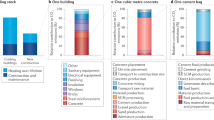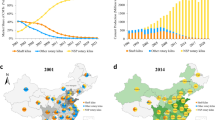Abstract
A country-level stock and flow model for cement, an important construction material, was developed based on a material flow analysis framework. Using this model, the contemporary cement cycle of the United States was constructed by analyzing production, import, and export data for different stages of the cement cycle. The United States currently supplies approximately 80% of its cement consumption through domestic production and the rest is imported. The average annual net addition of in-use new cement stock over the period 2000–2004 was approximately 83 million metric tons and amounts to 2.3 tons per capita of concrete. Nonfuel carbon dioxide emissions (42 million metric tons per year) from the calcination phase of cement manufacture account for 62% of the total 68 million tons per year of cement production residues. The end-of-life cement discards are estimated to be 33 million metric tons per year, of which between 30% and 80% is recycled. A significant portion of the infrastructure in the United States is reaching the end of its useful life and will need to be replaced or rehabilitated; this could require far more cement than might be expected from economic forecasts of demand for cement.
Similar content being viewed by others
References
van Oss HG, Padovani AC (2002) Cement manufacture and the environment, part I: chemistry and technology. J Ind Ecol 6(1):89–105
van Oss HG, Padovani AC (2003) Cement manufacture and the environment, part II: environmental challenges and opportunities. J Ind Ecol 7(1):93–126
ASCE (2005) Report card for America’s infrastructure. http://www.asce.org/reportcard/2005/index.cfm (as accessed on 04/17/05)
Aïtcin PC (2000) Cements of yesterday and today: concrete of tomorrow. Cement Concrete Res 30:1349–1359
Bakis CE, Bank LC, Brown VL, Cosenza E, Davalos JF, Lesko JJ, Machida A, Rizkalla SH, Triantafillou TC (2002) Fiber-reinforced polymer composites for construction — state-of-the-art review. J Compos Constr 6(2):73–87
Li VC (1998) Engineered cementitious composites — tailored composites through micromechanical modeling. In: Banthia A, Bentur A, Mufti N (eds) Fiber reinforced concrete: present and the future. Canadian Society for Civil Engineering, Montréal, pp 64–97
Uomoto T, Mutsuyoshi H, Katsuki F, Misra S (2002) Use of fiber-reinforced polymer composites as reinforcing material for concrete. J Mater Civil Eng 14(3):191–209
Van den Einde L, Zhao L, Seible F (2003) Use of FRP composites in civil structural applications. Constr Build Mater 17:389–403
Bringezu S, Schutz H (1997) Material flow accounts, part II: construction materials, packaging indicators. Wuppertal Institute, Wuppertal
Bergsdal H, Bohne RA, Bratteb H (2007) Projection of construction and demolition waste in Norway. J Ind Ecol 11(3):27–39
Baccini P, Brunner PH (1991) Metabolism of the anthrosphere. Springer-Verlag, Berlin, p 157
Graedel TE, van Beers D, Bertram M, Fuse K, Gordon RB, Gritsinin A, Kapur A, Klee RJ, Lifset RJ, Memon L, Rechberger H, Spatari S, Vexler D (2004) Multilevel cycle of anthropogenic copper. Environ Sci Technol 38(4):1242–1252
Graedel TE, van Beers D, Bertram M, Fuse K, Gordon RB, Gritsinin A, Harper EM, Kapur A, Klee RJ, Lifset RJ, Memon L, Spatari S (2005) The multilevel cycle of anthropogenic zinc. J Ind Ecol 9(3):67–90
Hashimto S, Tanikawa H, Moriguchi Y (2007) Where will large amounts of materials accumulated within the economy go? A material flow analysis of construction minerals in Japan. Waste Manag 27:1725–1738
Landner L, Lindeström L (1999) Copper in society and in the environment, 2nd edn. Swedish Environmental Research Group, Västerås
Smith RA, Kersey JR, Griffiths PJ (2003) The construction industry mass balance: resource use, wastes, and emissions. Virdis Report VR4 (revised), http://www.massbalance.org/downloads/projectfiles/1406-00112.pdf (accessed July 2008)
Kelly T (1998) Crushed cement concrete substitution for construction aggregates — a material flow analysis. U.S. Geological Survey, Circular 1177, Reston
Graedel TE, Bertram MB, Fuse K, Gordon RB, Lifset R, Rechberger H, Spatari S (2002) The contemporary European copper cycle: the characterization of technological copper cycles. Ecol Econ 42:9–26
van Oss HG (2003–2007) Cement chapter(s) in Minerals yearbook, 2001–2005. U.S. Geological Survey, Reston
Alsop PA, Chen H, Chin-Fatt AL, Jackura AJ, McCabe MI, Tseng HH (2005) Cement plant operations handbook for dry process plants. Tradeship, Dorking, p 257
Bhatty JI, Miller FM, Kosmatka SH (eds) (2004) Innovations in portland cement manufacturing. Portland Cement Association, Skokie, p 1367
Duda WH (1985) Cement data book, 3rd edn, vol I. French and European, Weisbaden, p 539
Portland Cement Association (2006) 2006 North American cement industry annual. Portland Cement Association, Skokie
BEA (2003) Fixed assets and consumer durables in the United States, 1925–97. Bureau of Economic Analysis, U.S. Department of Commerce, Washington, D.C.
Tam VWY, Tam CM, Le KN (2007) Removal of cement mortar from recycled aggregate using pre-soaking approaches. Resour Conserv Recy 50(1):82–101
Sandler K (2003) Analyzing what’s recyclable in C&D debris. Bio-Cycle 44(11):51–54
HQ AFCEE (2006) Construction and demolition waste management guide. HQ Air Force Center for Environmental Excellence, Brooks, p 42
USEPA (1998) Characterization of building-related construction and demolition debris in the United States. U.S. Environmental Protection Agency, Washington, D.C.
Tränkler JOV, Walker I, Dohmann M (1996) Environmental impact of demolition waste — an overview of 10 years of research and experience. Waste Manag 16(1–3):21–26
Taylor B (1999) Markets are set in concrete. Construction and demolition recycling. http://www.cdrecycler.com/articles/article.asp?ID=3488&AdKeyword=Brian+Taylor (as accessed on 07/12/06)
FHWA (2004) Transportation applications of recycled concrete aggregate, FHWA-IF-05-013. Federal Highway Administration, U.S. Department of Transportation, Washington, D.C., p 38
Harrington J (2006) Recycled roadways. Construction and demolition recycling. http://www.cdrecycler.com/articles/article.asp?ID=4878&AdKeyword=Recycled+Roadways (as accessed on 07/12/06)
Matthews E, Amann C, Bringezu S, Fischer-Kowalski M, Hüttler W, Kleijn R, Moriguchi Y, Ottke C, Rodenburg E, Rogich D, Schandl H, Schütz H, van der Voet E, Weisz H (2000) The weight of nations — material outflows from industrial economies. World Resources Institute, Washington, D.C.
USCB (2005) Construction statistics. http://www.census.gov/const/www/ (as accessed on 10/04/05) U.S. Census Bureau
FHWA (2006) Highway statistics 2000–2004. http://www.fhwa.dot.gov/policy/ohpi/hss/index.htm (as accessed on 06/10/06). Federal Highway Administration, U.S. Department of Transportation, Washington, D.C.
Kapur A, Keoleian G, Kendall A, Kesler S (2008) Dynamic modeling of in-use cement stocks in United States. J Ind Ecol 12(4): 539–556
Bolen WP (2003) Sand and gravel, construction — 2001. United States Geological Survey minerals yearbook 2001. U.S. Geological Survey, Reston
Tepordei VV (2003) Crushed stone — 2001. United States Geological Survey minerals yearbook 2001. U.S. Geological Survey, Reston
GBB (2006) GBB estimates 115 million metric tons per year of demolition waste generated in U.S. http://www.gbbinc.com/press_releases/nda-cd.htm (as accessed on 05/20/06)
Jones CL (2006) Making inroads. Construction & Demolition Recycling, March 2006, http://www.cdrecycler.com/articles/article.asp?ID=4877&AdKeyword=CMRA+survey (as accessed on 03/20/06)
Aquino JT (2003) C&D waste: a sometimes bumpy road to more attention. MSW Manag July/August 13(5) http://www.mswmanagement.com/july-august-2003/cd-waste-recycle.aspx (as accessed on 01/06/09)
Bader CD (2004) Where will all that C&D debris go? MSW Manag July/August 14(5) http://www.mswmanagement.com/july-august-2004/cd-debris-go-2.aspx (as accessed on 01/06/09)
Townsend T (2000) Converting C&D from volume to weight: a fact sheet for C&D debris facility operators. http://dep.state.fl.us/waste/quick_topics/forms/documents/62-701/reduction/converting.doc (as accessed on 01/06/09)
MDEQ (2003) Report of solid waste landfilled in Michigan, October 1, 2001–September 30, 2002. Michigan Department of Environmental Quality, Wastes and Hazardous Materials Division, Lansing
MDEQ (2004) Report of solid waste landfilled in Michigan, October 1, 2002–September 30, 2003. Michigan Department of Environmental Quality, Wastes and Hazardous Materials Division, Lansing
Sullivan E (2006) US cement market outlook 2006–2008. Global Cement and Lime Magazine, April, 53–60
van Oss HG, Kelly T (2005) Cement statistics. U.S. Geological Survey. http://minerals.usgs.gov/minerals/pubs/of01-006/cement.xls (as accessed on 03/21/06)
Simmons P, Goldstein N, Kaufman SM, Themelis NJ, Thompson J (2006) The State of garbage in America. BioCycle 47(4):26–43
Author information
Authors and Affiliations
Corresponding author
Rights and permissions
About this article
Cite this article
Kapur, A., van Oss, H.G., Keoleian, G. et al. The contemporary cement cycle of the United States. J Mater Cycles Waste Manag 11, 155–165 (2009). https://doi.org/10.1007/s10163-008-0229-x
Received:
Accepted:
Published:
Issue Date:
DOI: https://doi.org/10.1007/s10163-008-0229-x




